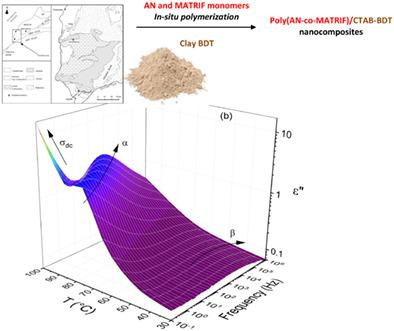当前位置:
X-MOL 学术
›
Polym. Compos.
›
论文详情
Our official English website, www.x-mol.net, welcomes your
feedback! (Note: you will need to create a separate account there.)
Dielectric and interfacial properties investigation of poly(acrylonitrile‐co‐2,2,2‐trifluoroethyl methacrylate) copolymer/organomodified beidellite clay nanocomposites
Polymer Composites ( IF 4.8 ) Pub Date : 2020-08-18 , DOI: 10.1002/pc.25762 Sirine Taktak 1 , Helmi Hammami 1 , Ali Kallel 1 , Fatima Ezzahra Bouharras 2 , Mustapha Raihane 2
Polymer Composites ( IF 4.8 ) Pub Date : 2020-08-18 , DOI: 10.1002/pc.25762 Sirine Taktak 1 , Helmi Hammami 1 , Ali Kallel 1 , Fatima Ezzahra Bouharras 2 , Mustapha Raihane 2
Affiliation

|
The dielectric properties of fluorinated cyano copolymer poly(acrylonitrile‐co‐2,2,2‐Trifluoroethyl methacrylate) (poly[AN‐co‐MATRIF]), reinforced with a natural Moroccan beidellite nanoclay organomodified with cetyltrimethylammonium bromide were studied. The effect of varying nanofillers loadings (1 wt%, 2 wt%, 3 wt%, and 5 wt%) on the molecular dynamics was investigated using broadband dielectric spectroscopy from 10−1 to 106 Hz and temperatures ranging between 30°C to 100°C. For the copolymer matrix, the real (ε′) and imaginary parts (ε′′) of the dielectric permittivity curves revealed three dielectric processes: the secondary β, the primary α and an ionic conduction phenomenon. Furthermore, incorporating of organomodified nanoclay, generated an additional relaxation process known as the Maxwell‐Wagner‐Sillars (MWS) interfacial polarization. The interface properties were investigated through the calculation of the strength parameters ∆εMWS using the WinFit impedance analysis software. At the range of 3 wt% of load, the orientation of the dipolar groups is reduced, caused by the high interaction and the strong adhesion involving the poly(AN‐co‐MATRIF) matrix and beidellite nanoclay. The part of nanoinclusions participating in the particle‐polymer interaction is increased, forming a rigid polymer/clay interfaces. The evaluated parameters confirm that a weight ratio of 3% of organomodified nanoclay is recommended to obtain a most performing nanocomposite that can serve in several applications such as fuel cells, lithium ion batteries, and photovoltaics.
中文翻译:

聚(丙烯腈-co-2,2,2-三氟甲基丙烯酸甲酯)共聚物/有机改性的贝得石粘土纳米复合材料的介电和界面性能研究
氟化氰基共聚物聚(丙烯腈的介电性质共-2,2,2-三氟乙基甲基丙烯酸酯)(聚[AN-共聚-MATRIF]),与天然的摩洛哥增强贝得石纳米粘土有机改性以十六烷基三甲基溴进行了研究。使用宽带介电谱从10 -1到10 6 Hz,温度范围为30°C至30°C,研究了纳米填料填充量(1 wt%,2 wt%,3 wt%和5 wt%)变化对分子动力学的影响。100℃。对于共聚物基质,实部(ε ′)和虚部(ε ′′)介电常数曲线的曲线揭示了三个介电过程:次级β,初级α和离子传导现象。此外,掺入有机改性的纳米粘土,还产生了另一种弛豫过程,称为麦克斯韦-瓦格纳-塞勒斯(MWS)界面极化。通过使用WinFit阻抗分析软件计算强度参数∆ε MWS,研究了界面特性。在3 wt%的负载范围内,偶极基团的取向降低,这是由于涉及聚(AN- co‐MATRIF)基质和贝得石纳米粘土。纳米夹杂物参与颗粒-聚合物相互作用的部分增加,形成刚性的聚合物/粘土界面。评估的参数证实,建议使用重量百分比为3%的有机改性纳米粘土,以获得性能最佳的纳米复合材料,该复合材料可用于多种应用,例如燃料电池,锂离子电池和光伏电池。
更新日期:2020-08-18
中文翻译:

聚(丙烯腈-co-2,2,2-三氟甲基丙烯酸甲酯)共聚物/有机改性的贝得石粘土纳米复合材料的介电和界面性能研究
氟化氰基共聚物聚(丙烯腈的介电性质共-2,2,2-三氟乙基甲基丙烯酸酯)(聚[AN-共聚-MATRIF]),与天然的摩洛哥增强贝得石纳米粘土有机改性以十六烷基三甲基溴进行了研究。使用宽带介电谱从10 -1到10 6 Hz,温度范围为30°C至30°C,研究了纳米填料填充量(1 wt%,2 wt%,3 wt%和5 wt%)变化对分子动力学的影响。100℃。对于共聚物基质,实部(ε ′)和虚部(ε ′′)介电常数曲线的曲线揭示了三个介电过程:次级β,初级α和离子传导现象。此外,掺入有机改性的纳米粘土,还产生了另一种弛豫过程,称为麦克斯韦-瓦格纳-塞勒斯(MWS)界面极化。通过使用WinFit阻抗分析软件计算强度参数∆ε MWS,研究了界面特性。在3 wt%的负载范围内,偶极基团的取向降低,这是由于涉及聚(AN- co‐MATRIF)基质和贝得石纳米粘土。纳米夹杂物参与颗粒-聚合物相互作用的部分增加,形成刚性的聚合物/粘土界面。评估的参数证实,建议使用重量百分比为3%的有机改性纳米粘土,以获得性能最佳的纳米复合材料,该复合材料可用于多种应用,例如燃料电池,锂离子电池和光伏电池。











































 京公网安备 11010802027423号
京公网安备 11010802027423号